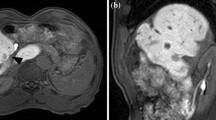Abstract
Hepatocellular carcinoma (HCC) can be difficult to diagnose and treat in patients with Osler–Rendu–Weber disease due to vascular malformation and regenerative nodular hyperplasia. In addition, percutaneous liver puncture should be avoided for the diagnosis and treatment as the procedure carries a high risk of bleeding. We herein report the successful treatment of HCC in a patient with Osler–Rendu–Weber disease using radiofrequency ablation (RFA) under laparoscopy. A 71-year-old man with Osler–Rendu–Weber disease was admitted to our hospital for the treatment of HCC. He also had chronic hepatitis C virus infection. The arterioportal shunts in the liver were detected by computed tomography (CT) and angiography. A tumor 20 mm in size was detected as a defected-lesion in the hepatic segment IV during the portal phase by CT. RFA under laparoscopy was performed for the curative treatment for HCC, with sufficient ablation obtained. Although the blood gushed out from the needle tract at the end of the procedure, complete hemostasis was achieved promptly using coagulation forceps. The post-operative course was favorable. Thus, laparoscopic RFA is a useful treatment modality for HCC in patients with Osler–Rendu–Weber disease, as a hemostasis device can be used with direct visualization.





Similar content being viewed by others
References
Garcia-Tsao G. Liver involvement in hereditary hemorrhagic telangiectasia (HHT). J Hepatol. 2007;46:499–507.
Buscarini E, Danesino C, Olivieri C, et al. Liver involvement in hereditary haemorrhagic telangiectasia or Rendu-Osler-Weber disease. Dig Liver Dis. 2005;37:635–45.
Wanless IR, Gryfe A. Nodular transformation of the liver in hereditary hemorrhagic telangiectasia. Arch Pathol Lab Med. 1986;110:331–5.
Buscarini E, Danesino C, Plauchu H, et al. High prevalence of hepatic focal nodular hyperplasia in subjects with hereditary hemorrhagic telangiectasia. Ultrasound Med Biol. 2004;30:1089–97.
Forner A, Llovet JM, Bruix J. Hepatocellular carcinoma. Lancet. 2012;379:1245–55.
Lee JH, Lee YS, Kim PN, et al. Osler-Weber-Rendu disease presenting with hepatocellular carcinoma: radiologic and genetic findings. Korean J Hepatol. 2011;17:313–8.
Blewitt RW, Brown CM, Wyatt JI. The pathology of acute hepatic disintegration in hereditary haemorrhagic telangiectasia. Histopathology. 2003;42:265–9.
Scelzo C, Greco S, Bonanni L, et al. The role of liver transplantation in the treatment of hereditary hemorrhagic telangiectasia: a short literature review. Transplant Proc. 2007;39:2045–7.
Gaujoux S, Bucau M, Ronot M, et al. Liver resection in patients with hepatic hereditary hemorrhagic telangiectasia. Dig Surg. 2013;30:410–4.
Morimoto N, Isoda N, Takaoka Y, et al. Short-term results of laparoscopic radiofrequency ablation using a multipolar system for localized hepatocellular carcinoma. Liver Cancer. 2017;6:137–45.
Casaccia M, Santori G, Bottino G, et al. Laparoscopic resection vs laparoscopic radiofrequency ablation for the treatment of small hepatocellular carcinomas: a single-center analysis. World J Gastroenterol. 2017;23:653–60.
Santambrogio R, Podda M, Zuin M, et al. Safety and efficacy of laparoscopic radiofrequency ablation of hepatocellular carcinoma in patients with liver cirrhosis. Surg Endosc. 2003;17:1826–32.
Cillo U, Vitale A, Dupuis D, et al. Laparoscopic ablation of hepatocellular carcinoma in cirrhotic patients unsuitable for liver resection or percutaneous treatment: a cohort study. PLoS One. 2013;8:e57249.
Herbold T, Wahba R, Bangard C, et al. The laparoscopic approach for radiofrequency ablation of hepatocellular carcinoma–indication, technique and results. Langenbecks Arch Surg. 2013;398:47–53.
Author information
Authors and Affiliations
Corresponding author
Ethics declarations
Conflict of interest
All authors declare that they have no conflict of interest.
Research involving human participants
All procedures followed have been performed in accordance with the ethical standards laid down in the 1964 Declaration of Helsinki and its later amendments.
Informed consent
Informed consent was obtained from the patient for being included in the study.
Rights and permissions
About this article
Cite this article
Takaoka, Y., Morimoto, N., Miura, K. et al. A successful treatment for hepatocellular carcinoma with Osler–Rendu–Weber disease using radiofrequency ablation under laparoscopy. Clin J Gastroenterol 11, 501–506 (2018). https://doi.org/10.1007/s12328-018-0877-x
Received:
Accepted:
Published:
Issue Date:
DOI: https://doi.org/10.1007/s12328-018-0877-x




